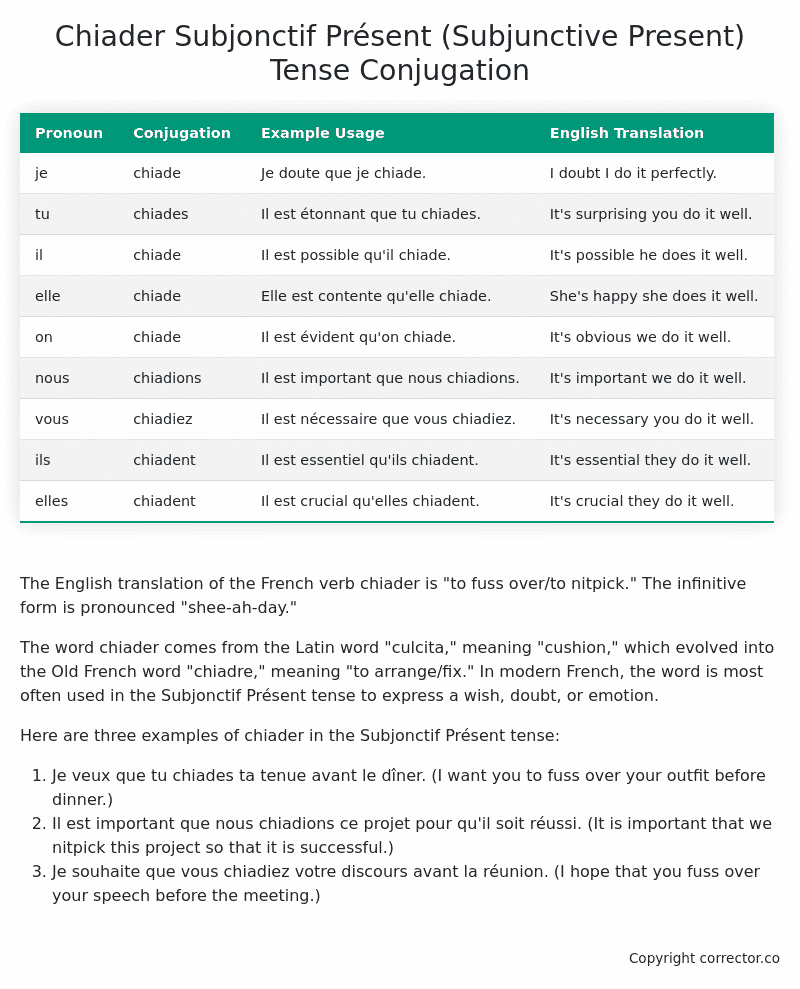Subjonctif Présent (Subjunctive Present) Tense Conjugation of the French Verb chiader
Introduction to the verb chiader
The English translation of the French verb chiader is “to fuss over/to nitpick.” The infinitive form is pronounced “shee-ah-day.”
The word chiader comes from the Latin word “culcita,” meaning “cushion,” which evolved into the Old French word “chiadre,” meaning “to arrange/fix.” In modern French, the word is most often used in the Subjonctif Présent tense to express a wish, doubt, or emotion.
Here are three examples of chiader in the Subjonctif Présent tense:
- Je veux que tu chiades ta tenue avant le dîner. (I want you to fuss over your outfit before dinner.)
- Il est important que nous chiadions ce projet pour qu’il soit réussi. (It is important that we nitpick this project so that it is successful.)
- Je souhaite que vous chiadiez votre discours avant la réunion. (I hope that you fuss over your speech before the meeting.)
Table of the Subjonctif Présent (Subjunctive Present) Tense Conjugation of chiader
| Pronoun | Conjugation | Example Usage | English Translation |
|---|---|---|---|
| je | chiade | Je doute que je chiade. | I doubt I do it perfectly. |
| tu | chiades | Il est étonnant que tu chiades. | It’s surprising you do it well. |
| il | chiade | Il est possible qu’il chiade. | It’s possible he does it well. |
| elle | chiade | Elle est contente qu’elle chiade. | She’s happy she does it well. |
| on | chiade | Il est évident qu’on chiade. | It’s obvious we do it well. |
| nous | chiadions | Il est important que nous chiadions. | It’s important we do it well. |
| vous | chiadiez | Il est nécessaire que vous chiadiez. | It’s necessary you do it well. |
| ils | chiadent | Il est essentiel qu’ils chiadent. | It’s essential they do it well. |
| elles | chiadent | Il est crucial qu’elles chiadent. | It’s crucial they do it well. |
Other Conjugations for Chiader.
Le Present (Present Tense) Conjugation of the French Verb chiader
Imparfait (Imperfect) Tense Conjugation of the French Verb chiader
Passé Simple (Simple Past) Tense Conjugation of the French Verb chiader
Passé Composé (Present Perfect) Tense Conjugation of the French Verb chiader
Futur Simple (Simple Future) Tense Conjugation of the French Verb chiader
Futur Proche (Near Future) Tense Conjugation of the French Verb chiader
Plus-que-parfait (Pluperfect) Tense Conjugation of the French Verb chiader
Passé Antérieur (Past Anterior) Tense Conjugation of the French Verb chiader
Futur Antérieur (Future Anterior) Tense Conjugation of the French Verb chiader
Subjonctif Présent (Subjunctive Present) Tense Conjugation of the French Verb chiader (this article)
Subjonctif Passé (Subjunctive Past) Tense Conjugation of the French Verb chiader
Subjonctif Imparfait (Subjunctive Imperfect) Tense Conjugation of the French Verb chiader
Subjonctif Plus-que-parfait (Subjunctive Pluperfect) Tense Conjugation of the French Verb chiader
Conditionnel Présent (Conditional Present) Tense Conjugation of the French Verb chiader
Conditionnel Passé (Conditional Past) Tense Conjugation of the French Verb chiader
L’impératif Présent (Imperative Present) Tense Conjugation of the French Verb chiader
L’infinitif Présent (Infinitive Present) Tense Conjugation of the French Verb chiader
Struggling with French verbs or the language in general? Why not use our free French Grammar Checker – no registration required!
Get a FREE Download Study Sheet of this Conjugation 🔥
Simply right click the image below, click “save image” and get your free reference for the chiader Subjonctif Présent tense conjugation!

Chiader – About the French Subjonctif Présent (Subjunctive Present) Tense
Formation of the Subjonctif Présent
Common Everyday Usage Patterns
Interactions with Other Tenses
Summary
I hope you enjoyed this article on the verb chiader. Still in a learning mood? Check out another TOTALLY random French verb conjugation!


